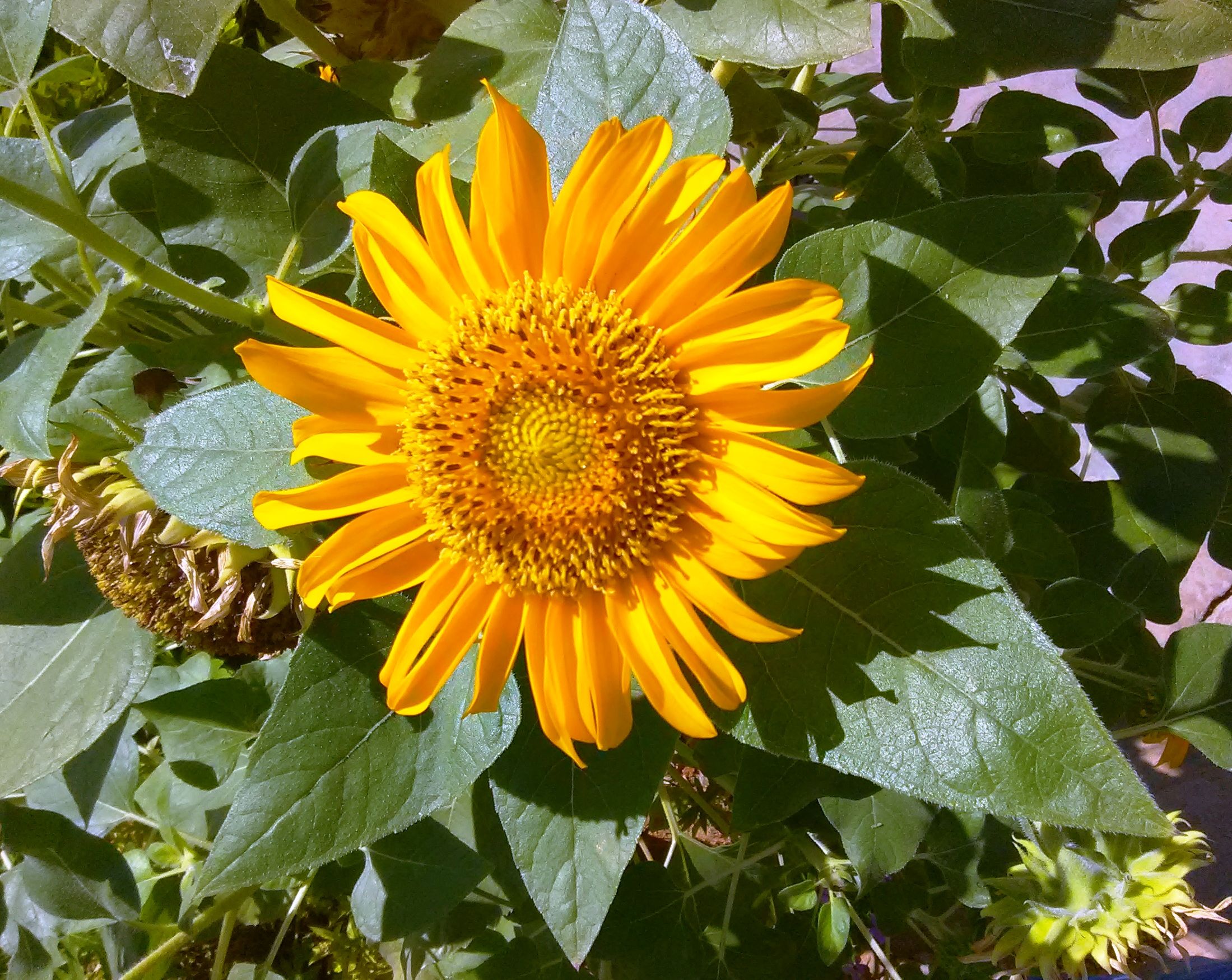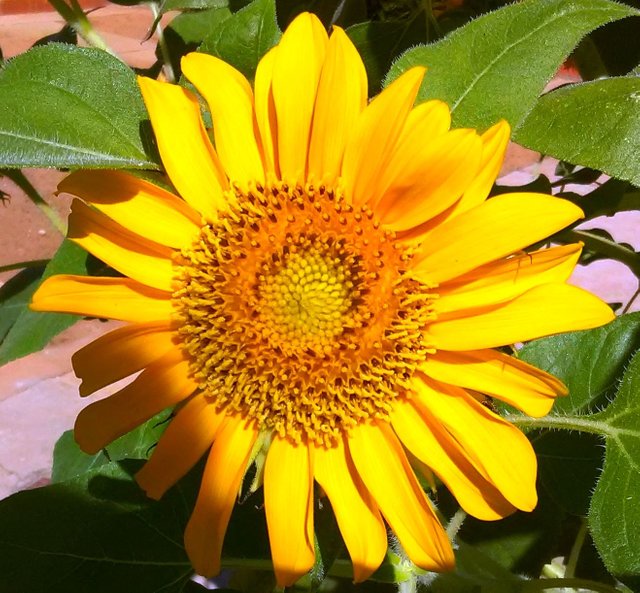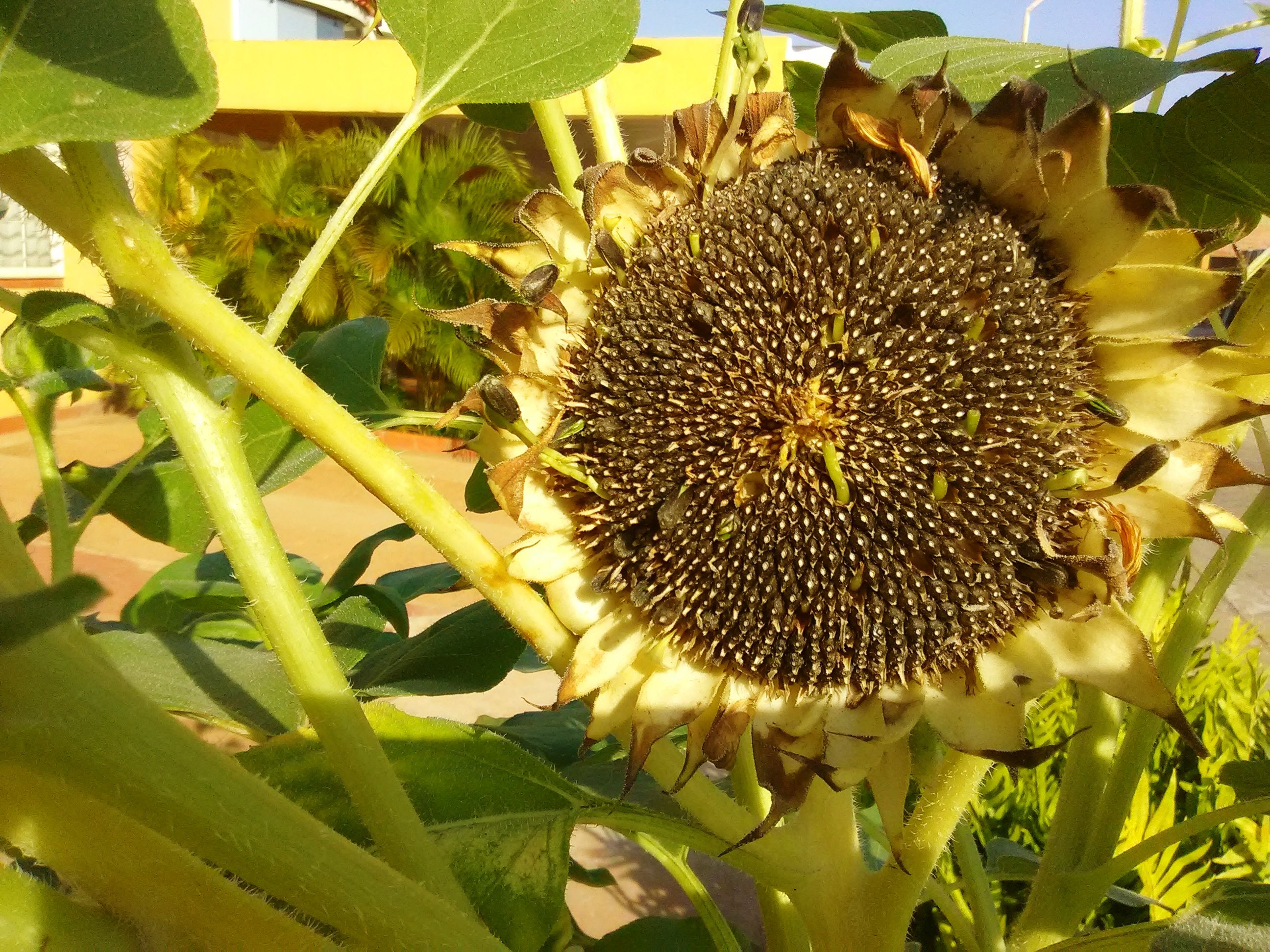Natural model of efficiency, optimization, and mathematical concepts
Hi Steemian friends!
Here I am again! this time with a very interesting topic. I confess that I like flowers and plants in general. Since I was a little girl I was attracted by the delicate and colorful beauty that they have. Caring for my mother's garden was a kind of relaxing therapy. The point is that I have the hobby of photographing flowers (nothing professional), in my account I have several publications with photographs of flowers of different colors and species. I recently took several of a very striking flower, the Sunflower (Helianthus annuus) and today I want to share them with you along with what has been investigated about it up to now.

Photo: @ufv – Camera: ZTE fanfare 5MP
It is a very beautiful flower and very showy, its colors and shape resemble the sun. Its particular movement chasing it is simply fascinating. It belongs to the family of Asteráceas and is native to Central America. Its striking beauty and its many uses have made it very popular and very cultivated in many places in the world.
The unique movement made by the Sunflower has been studied recently (2016) by a team of biologists from the Universities of California and Virginia of the United States. The results of this research were published in the journal Science.
These researchers sought to explain this movement during the day, as well as why it also does so during the night when the energy stimulus no longer exists. They also intended to explain why, when they complete their development, they stop spinning, remaining in a fixed position facing the East as if waiting for the sunrise all the time.
This tracking of solar energy is known in botany as Heliotropism and makes the Inflorescence always be in position facing the sun. It is a very effective mechanism in which plants species have access to the greatest amount of light, necessary for photosynthesis and for their normal development.
To find answers to these questions, they carried out tests in which they cultivated sunflower plants in pots and then placed them facing east every evening so that at dawn they would be in opposite position to the sunrise, they prevented the natural movement of rotation of Young Sunflowers holding their stems to fixed supports, another group of plants were illuminated with a blue Led light simulating the sun's rays and finally they subjected another group of Sunflowers to abnormal cycles of 30 hours a day/night.
After many trials, it was observed in the Sunflowers a decrease of the size of the leaves and of the dry biomass of the plants (10%) was registered, as a consequence of the reduction of the insolation received. Then, the researchers concluded that this movement allows for the Sunflower to more efficiently capture solar energy (photosynthetic efficiency).

Photo: @ufv – Camera: ZTE fanfare 5MP
The researcher at the University of California, Stacey Harmer, explains that the growth of the sunflower stems is asymmetrical and that the shadow side grows more than the sunlit side during the day which causes its inclination towards the sun. Affirms that in this process participate photoreceptors called Phototropins and a hormone called Auxin.
For a better understanding, we should know that plant hormones (Phytohormone) are responsible for the growth of all parts of plants (leaves, stem, root, flower, and fruit ). These hormones are produced in any part of the plant and thanks to them the tissues of the same grow, harden or swell. One of these hormones is the Auxin also known as growth hormone and widely used in the production of human and animal food. Its function is to make the cells multiply and in this way the plant grows. It is generated naturally in growing plants and is affected (inhibited) by light, that is, when a part of the plant is exposed to light it stops producing auxin and accumulates it in those parts that are in the shade, which grow more than the illuminated ones.
Other observations visualized in these experiments were that the Sunflowers that were artificially illuminated performed their normal turns from East to West for several days and those that were exposed to the simulation of a day of 30 hours showed strange and abnormal behavior. Then the biologists inferred that not only the environmental stimulus explained the nocturnal rotation of the flower (from West to East) but that it had to intervene circadian rhythm of the plant.
"We need more studies, but in general terms, we believe that the growth of the west side of the stems is controlled by the circadian clock, while the east side is managed by the signaling mechanism of the photoreceptors. back-forward bending we see in plants that follow the sun, "says Harmer.
Now, what is the rhythm or Circadian clock?
The circadian rhythm is an internal clock or mechanism that temporarily organizes the physiology and metabolism of the organism with a period of 24 hours, hence its name (from the Latin circa = around and dies = day). According to research carried out so far, it is present in humans, plants, insects, fungi and even some bacteria. These rhythms are regulated by the environmental conditions of day and night, however, it is autonomous since they can also work without them existing. What has been investigated of the circadian clock indicates that it is synchronized by environmental conditions every day and the best example of this synchronization is the phenomenon of Jet lag or transoceanic syndrome in which the internal clock of the human being reorganizes the sleep/wake periods to adapt them to the time zones.
In the case of plants, researchers say that this internal clock or circadian rhythm is an adaptive advantage since these rhythms occur at the most appropriate time for the plant and also allows you to anticipate environmental changes that may affect your survival (temperature, lighting, etc).
 Photo: @ufv – Camera: ZTE fanfare 5MP
Photo: @ufv – Camera: ZTE fanfare 5MPIn the specific case of the Sunflower, the biologists of the Universities of California and Virginia affirm that the process of Heliotropism that causes the plant to follow the solar route is produced by the joint operation of the Phototropins and the circadian clock of the same. There is a relationship between the growth of the plant and the circadian rhythm and this is explained because when the sunflower reaches maturity the mechanism that makes it turn and lean towards the sun disappears remaining static in position facing the sun.
It would only be necessary to answer why after stopping their turn, the Sunflowers point towards the east. For this, the researchers observed with infrared cameras the plants that were facing east and also those that were facing west at dawn and estimated that those facing the rising sun showed greater warming in the morning hours and attracted greater numbers of pollinators.
This is logical if we analyze the fact that in its maturity the plant needs to reproduce.
So, dear friends, we have seen how investigations have allowed us to know a lot about this beautiful flower. But there is more!
Sunflower seeds have also been the subject of studies by biologists, mathematicians, and physicists since they present a very characteristic arrangement forming an angle of 137 degrees between them. This arrangement does not allow to shadow each other which translates into greater use of sunlight. This formation usually consists of a group of spirals with sense to the right and another group with sense to the left following an order corresponding to the Succession of Fibonacci.
In mathematics, the Fibonacci sequence is the next infinite sequence of natural numbers:0, 1, 1, 2, 3, 5, 8, 13, 21, 34, 55, 89, 144, 233, 377, 610, 987, 1597, …
The sequence begins with the numbers 0 and 1, and from these, "each term is the sum of the two previous ones", is the relation of recurrence that defines it. The elements of this sequence are called Fibonacci numbers.
By dividing each term of this succession with the previous one, the result is approximated to the golden number. This number can be found in nature, for example, the flowers are 3, 5, 8, 13 or 31 petals, the rows or spirals of the scales of a pineapple are rolled to the right and to the left in 13 and 21 spirals respectively. In pine cones or pineapples, the arrangement of bracts is another example, the layout of the leaves of plants (phyllotaxis), among others.
In the case of Sunflower its spirals always meet that they are two consecutive numbers of the Fibonacci Succession (55 spirals to the right and 89 spirals to the left or 89 spirals to the right and 144 spirals to the left).
The study of this efficient distribution has served as a model for the optimization of solar energy generation.
In a solar concentration plant (CSP) a large number of mirrors are installed or Heliostats distributed in concentric semicircles around a central tower that is responsible for transforming the heat into electricity. In this distribution, although there is a robotic mechanism in charge of making these mirrors follow the path of the sun, there is a moment in the day when they become shadowed between them, which affects the efficiency of the panels.
The Technological Institute of Massussets, studying a distribution that solves this problem, decided to design a new arrangement of the solar panels taking as a model the one observed in the sunflower seeds. In this way they placed the panels in spirals with an angle of 137 degrees between each spiral getting a better use of solar energy and significantly reducing the amount of space occupied by the plant (16% less space).

With this, dear friends, I conclude this publication that I wanted to share with you, in which besides knowing the operation of such a beautiful and interesting plant, we have seen how nature sometimes offers possible solutions to human problems and serves as inspiration for the development of most optimal processes or systems.
I hope you liked this content and I wish you a very happy day!
References:
- https://www.investigacionyciencia.es/noticias/la-aritmtica-del-girasol-11182
- https://www.dr.hauschka.com/es_ES/sabiduria-terapeutica/plantas-medicinales/girasol/
- http://science.sciencemag.org/content/353/6299/587.full
- http://sedin-notas.blogspot.com/2016/08/el-complejo-movimiento-del-girasol.html
- https://www.lainformacion.com/interes-humano/planta/GIRASOLES-INTERNO-SEGUIR-CRECER-RAPIDO_0_941606142.html
- http://www.abc.es/ciencia/abci-averiguan-girasoles-siguen-201608042105_noticia.html
- http://sedin-notas.blogspot.com/2016/08/el-complejo-movimiento-del-girasol.html
- https://en.wikipedia.org/wiki/The_Power_of_Movement_in_Plants
- http://www.bbc.com/mundo/noticias/2012/01/120123_girasol_energia_solar_am

Excellent post @ufv. Thanks for sharing!.
Regards.
thanks for the support @tsoldovieri, it is a pleasure to share. Regards